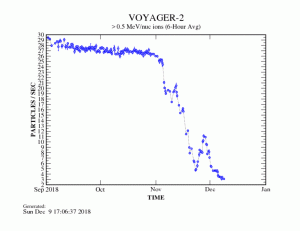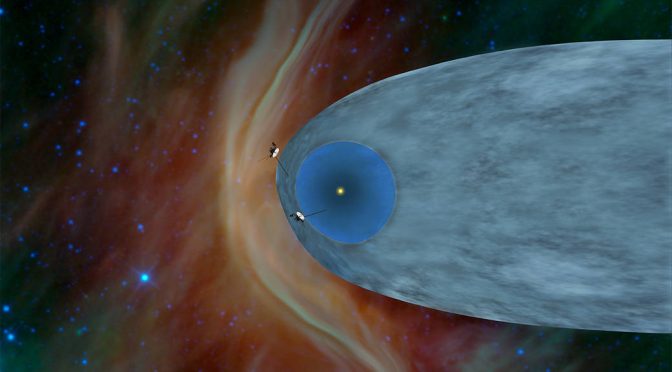Well, perhaps more precisely, the Voyager II spacecraft is now making its way through the heliopause region. Unlike planetary magnetospheric boundaries, the boundary between the heliosphere and the local interstellar medium (LISM) has substantial thickness compared to the length scales that Voyager II samples based on its data cadence and its velocity. It will take Voyager II time to make it completely through the region, but the data make it abundantly apparent that one of our oldest operating spacecraft is now set to join its twin as an interstellar traveler having entered the heliopause on November 5 at a distance of 119 AU, 35 AU past the termination shock.
Most of the data gathered by the spacecraft that indicate that Voyager II is now exploring a very different region of space are the sudden drop in the energetic ion intensity (E ~ 1 MeV/nuc) coupled with the simultaneous increase in the galactic cosmic ray intensity (E ~ 100 MeV/nuc). There are strong indicators in the magnetic field data as well. The field is significantly stronger than previously observed, there’s an absence of variation, and the field has a northward (+BN) component. All of this is consistent with what Voyager I saw when it entered the LISM.

There are some significant differences between the Voyager I and II observations, though. The timescales of the transitions are very different with the Voyager II data showing a slower transition than as seen by Voyager I. The spectra for energetic hydrogen and helium ions (protons and alpha particles) also showed very little variation at Voyager II and compared to the change seen at Voyager I.
While many of the trends in the data are similar between the two spacecraft, these few and important differences will help the team to further refine our model for the shape of the heliosphere. Early models held that the heliopause was open and teardrop shaped, not unlike the shape of planetary magnetospheres. As the interstellar wind impacts the Sun’s magnetic field, it pushes on and distorts the field forming a tail structure downstream and a bow shock upstream. The data from Voyager I and the preliminary data from Voyager II coupled with remote sensing data from platforms in Earth orbit and on the now destroyed Cassini orbiter around Saturn are leading many to the conclusion that our heliosphere is a closed asymmetric bubble.
Fortunately, both Voyager spacecraft still enjoy good health for their age. The both still have plenty of fuel, but what they are both running low on is power. Solar panels simply won’t work when you’re 100 AU from the Sun. At the distance of the heliopause, you would need over 14,000 times more solar panels to provide the same amount of power that you could produce in Earth orbit. This is why the Voyager spacecraft are powered by radioisotope thermoelectric generators (RTGs). Small lumps of a highly radioactive isotope of plutonium provide a large amount of heat. That heat energy is then converted into electrical energy to provide power to the spacecraft. However, over the past 41 years of flight, the plutonium sources have decayed and cooled, therefore reducing the amount of electricity the RTGs can provide. Both spacecraft have the power they need for the instruments that are still on, but they’re losing power at a rate of 4 W/yr. Some hard decisions will need to be made very soon between turning on heaters, turning off some science instruments, or trying a time sharing scheme. The trouble is every on/off transition can result in an improper commanding sequence on Voyager II that could irreparably damage the spacecraft, and it’s not like we can send a repair crew to service them.
The two Voyagers are the most amazing missions of space exploration ever launched. The amount by which their data has advanced our understanding of the outer solar system and our Sun is beyond anything that any other single mission has provided, and they’re still going! Here’s hoping that we get a few more good years from our now TWO interstellar spacecraft.
The official press release can be found here:
https://www.nasa.gov/press-release/nasa-s-voyager-2-probe-enters-interstellar-space


